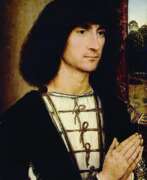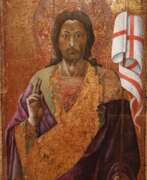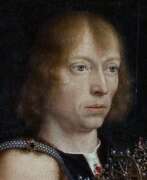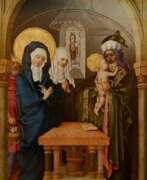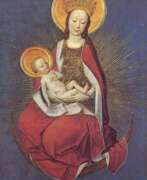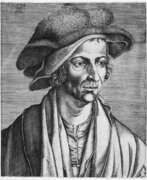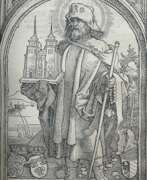Northern Renaissance 15th century
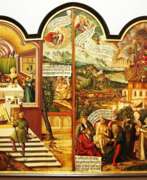

Erhard Altdorfer, a German Early Renaissance printmaker, painter, and architect, is renowned for his contributions to the arts during the 16th century. Born around 1480, Altdorfer's career flourished in Schwerin, where he served as a court painter and architect for the Dukes of Mecklenburg from 1512 until his death in 1561. His journey into the arts likely began under the guidance of his older brother, Albrecht Altdorfer, a prominent figure in the same era.
Altdorfer's early work possibly included collaboration with his brother in Regensburg. By 1512, his talents led him to Schwerin, marking the start of a significant phase in his career. His oeuvre includes various forms, from engravings and woodcuts to paintings and architectural designs. Notable among his works are contributions to the Lübeck Bible, showcasing his skill in woodcut illustrations. Despite the limited number of signed works, his contributions to printmaking and painting hold a place in the history of German Renaissance art. His works, reflecting a blend of influences, including from Lucas Cranach the Elder and Jacopo de' Barbari, demonstrate a unique interpretation of the Renaissance style.
For collectors and experts in art and antiques, understanding Altdorfer's role within the context of the Early Renaissance and his contributions, especially in printmaking and painting, offers a nuanced appreciation of this period. His works, though not as prolifically signed as those of some contemporaries, remain significant for their historical and artistic value. To stay updated on new discoveries or auction events related to Erhard Altdorfer's works, consider signing up for updates to deepen your knowledge and collection of Renaissance art.
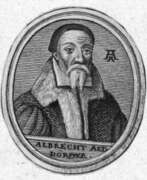

Albrecht Altdorfer, a notable German painter, engraver, and architect of the Renaissance era, was especially recognized for his contributions to landscape painting. Born around 1480, Altdorfer was a pivotal figure in the Danube School, distinguishing himself with his integration of natural landscapes into biblical and historical narratives.
His works are celebrated for their detailed and expressive landscapes, often serving as backdrops to religious and historical scenes. A hallmark of his style is the emotional intensity and vivid use of colors, which border on expressionistic in his religious scenes, particularly seen in works like the Sebastian Altar in St. Florian's Priory. Altdorfer's painting, "The Battle of Alexander at Issus," stands out for its epic portrayal of Alexander the Great's victory, showcasing Altdorfer's talent in blending historical narrative with dramatic landscape settings.
In addition to his artistic pursuits, Altdorfer was actively involved in the civic life of Regensburg, serving as its mayor in 1528. His legacy in the art world is profound, with his innovative approach to landscape painting influencing the course of European art.
For those interested in delving deeper into Albrecht Altdorfer's oeuvre or staying informed about related exhibitions and auction events, signing up for updates can provide valuable insights and opportunities.
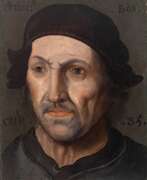

Hieronymus Bosch, a Netherlandish painter born around 1450 in 's-Hertogenbosch, remains one of the art world's most enigmatic figures. Bosch's work is renowned for its intricate, symbolic, and often unsettling imagery, depicting fantastical creatures, earthly pleasures, and human folly with a depth that continues to fascinate scholars and art lovers alike. Despite the scarcity of biographical details—owing to the lack of personal letters or diaries—Bosch's legacy as a pivotal figure in the transition from the medieval to the modern worldview is undisputed.
Bosch spent virtually his entire life in his birthplace, where his family had deep roots in the artistic community. His grandfather and father were both painters, suggesting that Bosch likely received his initial training within his family. By the late 15th century, Bosch had become a respected member of the local Brotherhood of Our Lady, contributing significantly to the cultural and religious life of his community through his artworks. Notably, Bosch's oeuvre includes around thirty paintings, with "The Garden of Earthly Delights," a triptych full of intricate, allegorical imagery, standing out as one of his masterpieces. This work, alongside others such as "The Temptation of St. Anthony" and "The Haywain Triptych," showcases Bosch's unique ability to blend religious themes with his vivid imagination, offering commentary on human sin and redemption.
Bosch's art, characterized by its detailed landscapes populated with a myriad of creatures both heavenly and demonic, reflects a deep moral concern with the fate of humanity, yet leaves much to interpretation. His works are preserved in some of the world's most prestigious museums, including the Museo del Prado in Madrid, where "The Garden of Earthly Delights" is housed, underscoring his lasting impact on the cultural and artistic heritage of the Renaissance period.
Despite the challenges in attributing some works definitively to Bosch due to the absence of signatures on many of his paintings, about 25 paintings and eight drawings are confidently ascribed to him, with others attributed to his workshop. Bosch's influence extended beyond his lifetime, notably inspiring Pieter Bruegel the Elder, and continues to captivate contemporary audiences with his complex iconography and detailed panoramic scenes.
For collectors and experts in art and antiques, Bosch's work represents a fascinating intersection of culture, art, and the human condition, offering endless avenues for exploration and appreciation. To stay updated on new discoveries, sales, and auction events related to Hieronymus Bosch, signing up for updates can provide exclusive insights and opportunities to deepen one's understanding and collection of this remarkable artist's work.
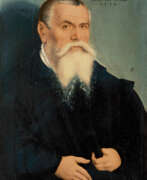

Lucas Cranach the Elder was a pivotal figure in German Renaissance art. As a leading painter of Saxony, his influence spanned across the 16th century, making significant contributions through his paintings, woodcuts, and engravings. His artistic journey began under the tutelage of his father, Hans Maler, and saw him becoming court painter to the Elector of Saxony, where he produced a vast array of works including altarpieces, court portraits, and notably, portraits of Protestant Reformers.
Cranach's artistry was not confined to any single genre. He was renowned for his portraits of the aristocracy, deeply symbolic religious paintings, and engaging mythological scenes. His ability to capture the essence of the Protestant Reformation, notably through his portraits of Martin Luther, showcases his close connection to the movement and his role as a key figure in conveying its ideals through art.
A significant part of Cranach's legacy is his workshop in Wittenberg, which was a hub of artistic production. This workshop produced numerous works that bore his distinctive winged serpent signature, a mark of quality and innovation in the art of the period. Cranach's workshop was known for its efficient operation, enabling the production of a large volume of works that catered to the high demand of his time.
For collectors and experts in art and antiques, Lucas Cranach the Elder's work represents an intriguing intersection of art, culture, and history. His contributions to Renaissance art and his unique portrayal of religious and mythological themes continue to captivate audiences, making his work highly sought after in the world of art collection.
To explore more about Lucas Cranach the Elder's fascinating contributions to art and to stay updated on new discoveries or auction events related to his works, consider signing up for specialized updates. This subscription is designed for enthusiasts keen on delving deeper into the rich tapestry of Renaissance art and history, ensuring they remain well-informed of relevant sales and scholarly insights.
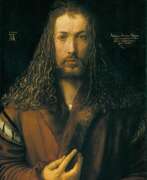

Albrecht Dürer, born on May 21, 1471 in Nuremberg, Germany, is widely regarded as the greatest German Renaissance painter. His contribution to painting and engraving is quite significant and has left a notable mark on the art world. Dürer's early life was spent in Nuremberg, a city that played a crucial role in his development as an artist and was also the site of his death on April 6, 1528. He was the son of the goldsmith Albrecht Dürer the Elder, from whom he initially learned the basics of drawing and metalworking.
Dürer's work is characterized by a combination of Gothic elements with the emerging Renaissance style, which is evident in his woodcuts and engravings. His oeuvre encompasses many themes, including religious works, altarpieces, portraits, and self-portraits. His outstanding prints, such as The Knight, Death and the Devil (1513), St. Jerome in his Study (1514) and Melencolia I (1514), are known for their intricate detail and artistic skill. Dürer was also one of the earliest European landscape painters, as evidenced by his watercolor paintings.
Equally significant are his theoretical writings on mathematics, perspective, and ideal proportions in art. Dürer was not only an artist but also a keen intellectual, his interests encompassing various aspects of culture and science. He served as court painter to Holy Roman Emperors Maximilian I and Charles V, completing several significant art projects for them. Dürer's keen mind and versatile interests brought him into contact with the most prominent figures of his time, including theologians and scientists of the Reformation era.
Dürer's self-portraits are particularly famous, demonstrating not only his artistic skill but also his self-awareness and personal style. These portraits attest to his growing success and confidence as an artist. Dürer's legacy is immense; he influenced not only the art of his time, but also left an indelible mark on the history of European art.
For those interested in the work and legacy of Albrecht Dürer, we recommend subscribing to our updates. Our subscription service is designed to provide information about new sales and auction events related to this remarkable artist. Join us to keep up to date on the latest art and antiques related to Albrecht Dürer.
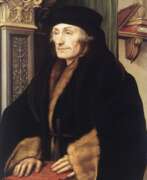

Desiderius Erasmus, also Erasmus of Rotterdam, or simply Erasmus (Latin: Desiderius Erasmus Roterodamus, Dutch: Gerrit Gerritszoon) was a Dutch humanist, philosopher, and the greatest scholar of the Northern Renaissance.
He was illegitimate and brought up under the name Gerhard Gerhards, later in Latin his name was dubbed Desiderius Erasmus. At the age of 13, the boy was sent to a monastery, where he later took the ministry. Erasmus read a lot, improving in Latin and Ancient Greek, studied oratory. A few years later he received the post of secretary to the bishop of the French city of Cambre. From 1493 to 1499 Rotterdam lived in Paris, then in London he was introduced to Thomas More, John Fisher, and John Colet.
Erasmus was constantly on the move, rarely staying in one place and traveling frequently between the Netherlands, Britain, France and Italy. In Turin he earned a doctorate in theology and was received by the Pope, then taught ancient Greek and theology at Cambridge. He corresponded with the rulers of various countries, popes and cardinals, and with statesmen, answering their questions of a scientific, political, and philosophical nature. As a true humanist, Erasmus of Rotterdam adhered to the ideas of a scientific spirit that favored research and true knowledge.
Among the merits of Rotterdamsky study of religious texts from a scientific position, critical interpretation of theology. Erasmus was able to lay the groundwork for historical-critical study of the past, especially in his studies of the Greek New Testament and the church fathers. His educational writings helped to replace the old school curriculum with a new humanistic emphasis on the classics.
In 1501, Erasmus produced a religious and ethical treatise, The Arms of the Christian Warrior, published in 1504. His work entitled "The Praise of Folly" was reprinted 40 times only during the author's lifetime, the book has been translated into all popular languages of the world. The series "Conversations in a Simple Way" (1518-1533) is among the most popular books on pedagogy. Erasmus promoted respect and care for children, opposing violence and corporal influence. He also promoted the idea that education should be compulsory for everyone.
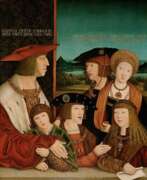

Bernhard Strigel was a German painter of the Swabian school, one of the most important masters of the transitional period between the Gothic and the Renaissance.
Bernhard came from a family of artists from Memmingen. He painted works on religious and historical subjects, but became more famous as a portrait painter. The artist painted many portraits of noble citizens of his time in the spirit of the early Northern Renaissance.
Strigel enjoyed the patronage of Emperor Maximilian I and in 1515 became his court painter in Vienna. Here in the same year he created one of the earliest group portraits in Germany, a depiction of Maximilian I and his family. In the last years of his life he gave up religious work and devoted himself almost exclusively to portraiture.
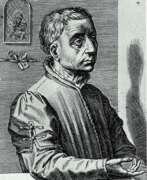

Rogier van der Weyden, birth name Rogier de le Pasture, was a Dutch painter, a classic of the Northern Renaissance.
Rogier van der Weyden was one of the most important and influential artists of the Flemish Northern Renaissance, along with Jan van Eyck and Robert Kampen. He became the official painter of the city of Brussels and executed works for the Duke of Burgundy, who ruled the region at the time. Van der Weyden's groups of figures and compositions for portraits and biblical scenes inspired subsequent generations of artists, and his ability to convey strong emotion has been recognized as one of his major contributions to European art. He is considered the first European artist to depict people crying.
The most powerful on the emotional impact on the viewer can be considered the canvas of the artist "The removal from the cross" (1435-1440), it is one of the peaks of European fine art XV century. Currently, the painting is stored in the Prado Museum in Madrid.
One of Rogier van der Weyden's sons, grandson and great-grandson also became artists.
